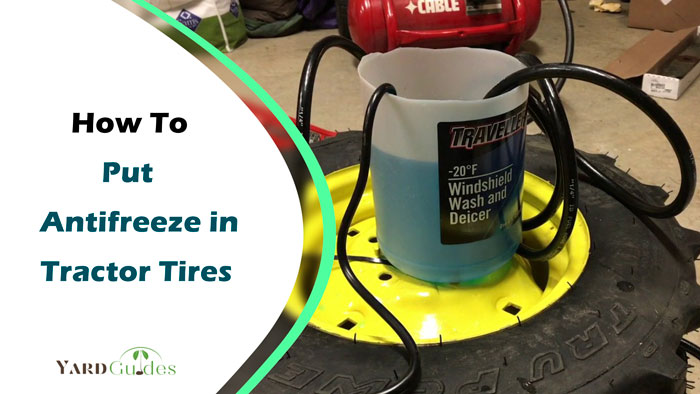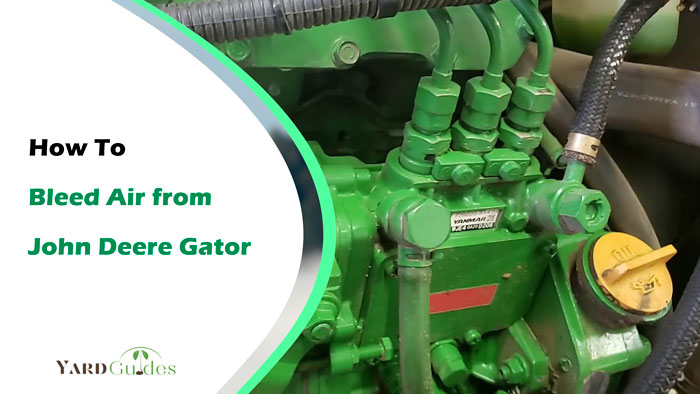Antifreeze is a special liquid that prevents water from freezing in the tire. It helps keep your tractor tires in good condition throughout the winter. Filling up your tires with antifreeze is simple, but you need to be careful as it’s toxic.
So, how to put antifreeze in tractor tires? First, you must determine the type and amount of antifreeze to use according to your tractor manual. Then clean and inspect the tractor tires for damage or punctures. Remove the tires and fill them with the antifreeze mixture to the recommended level.
That’s not all! In this article, we’ll walk you through the necessary steps to put antifreeze in your tractor tires. So keep reading till the end.
Why Do You Need Antifreeze?
Antifreeze is commonly used in colder regions where snowfall is common and temperatures can drop dangerously low.
Water frequently freezes in such areas, causing problems, particularly for farming, as tractors rely on water-filled tires. Without antifreeze, tractor tires can become overly heavy due to ice accumulation, resulting in slower movement and potential engine and suspension damage.
How To Put Antifreeze in Tractor Tires
Most tractors use ethylene glycol antifreeze, but some newer models use propylene glycol antifreeze. Check your tractor’s manual to see which type to use. This needs to be cleared because you need to know the exact antifreeze type before applying it to the tires.
After choosing the right type of antifreeze, here is a step-by-step guide on how to add antifreeze to tractor tires.
Step 1: Gather Your Materials
Before you begin, ensure you have the necessary tools and equipment. You’ll need-
- A tire valve stem remover
- A funnel or tire hose
- A measuring cup
- A container to hold the antifreeze
- Water
Step 2: Remove The Valve Core
Remove the valve core from the tire’s valve stem to be filled with antifreeze using a tire valve stem remover. Keep the valve core safe, so you don’t lose it.
Step 3: Drain The Tire
Allow the tire to drain completely after removing the valve core. Lift the tire and rotate it, so the valve stem is at the bottom.
Step 4: Measure The Antifreeze
Next, measure the amount of antifreeze required for your tire. In general, the liquid in the tire should be mixed with water: 50% antifreeze and 50% water. The amount will be determined by the size of the tire and the manufacturer’s recommendations. Use the measuring cup to get the correct amount.
Step 5: Pour In The Antifreeze
Pour the measured amount of antifreeze into the tire through the valve stem using the funnel. Pour it slowly to avoid spilling it. If you spill antifreeze, clean it up immediately because it can harm pets and wildlife.
Another way to put the antifreeze in the tire is through a tire hose. You will need to put the antifreeze in a liquid adaptor and then connect the liquid adaptor to your tire through a tire hose.
Screw the other end of the hose onto the liquid adaptor using a clockwise motion until it can no longer be twisted. Tire hoses can be purchased online or at select agricultural supply stores.
Step 6: Reinstall The Valve Core
After you’ve added the antifreeze, use the valve stem remover to reinstall the valve core. Make sure it’s securely tightened, so it doesn’t leak.
Step 7: Rotate The Tire
Finally, rotate the tire to distribute the antifreeze evenly. This can be accomplished by lifting the tire and rotating it several times.
You’ve successfully added antifreeze to your tractor’s tire, and you can now relax knowing that your tires are safe from freezing and cracking during the winter. Here is a video to help you out-
How Do I Remove Antifreeze In Tractor Tires
You may need to remove the old antifreeze before adding the new one. Removing antifreeze from tractor tires can be a difficult task, but it is doable in a few steps:
- Step 1: Drain the antifreeze from the tractor tires completely. This is accomplished by removing the valve stem from the tire and allowing the antifreeze to drain in a large basin.
- Step 2: Once the antifreeze has been drained, thoroughly rinse the tires with water to remove any remaining antifreeze.
- Step 3: Cleaning solutions specifically designed to remove antifreeze from tires are available. Pour the solution into the tire and allow it to sit for a while before draining it and rinsing.
- Step 4: Depending on how much antifreeze was in the tires, it may be necessary to repeat the draining, rinsing, and cleaning process multiple times to ensure that all the antifreeze is removed.
- Step 5: After the tires are clean and dry, it is essential to check the tire pressure and adjust it as needed.
Advantages And Disadvantages Of Putting Antifreeze In Tractor Tires
Adding antifreeze to tractor tires has both advantages and disadvantages. It’s essential to consider both before deciding whether or not to use antifreeze in your tractor tires.
Pros:
- Freezing protection: Antifreeze prevents the tires from freezing in cold weather. This helps to prevent damage from the contraction and expansion of water within the tire, which can cause cracks and other problems.
- Increased durability: Antifreeze can help extend your tires’ life by preventing cracking caused by cold weather exposure.
- Improved tractor performance: Antifreeze-filled tires can provide better traction, which is useful when operating on slick or uneven terrain.
- No need for weight: Adding antifreeze to the tires adds weight, which can help balance the tractor and increase traction. This can eliminate the need to add extra weights to the tractor, which can be time-consuming and costly.
Cons:
- Cost: Purchasing antifreeze can be expensive, especially if you have a large tractor with multiple tires.
- Environmental concerns: If antifreeze is not correctly disposed of, it can harm the environment. It is critical to dispose of used antifreeze by local regulations properly.
Conclusion
Adding antifreeze to tractor tires is a simple and effective way to protect the tires from damage during the winter. You can add antifreeze to your tractor’s tires and protect them from damage caused by freezing temperatures by following the steps outlined in this article and taking the necessary precautions.
It is critical to take precautions when adding antifreeze to tractor tires to ensure your safety and the safety of others. Antifreeze is toxic and can be dangerous if consumed. It is critical to wear gloves and avoid skin and eye contact. If you spill antifreeze, clean it up immediately to avoid contaminating the environment.



